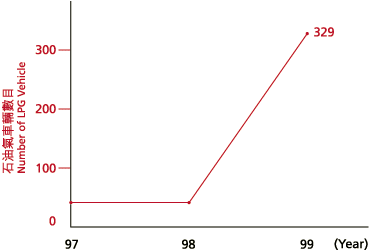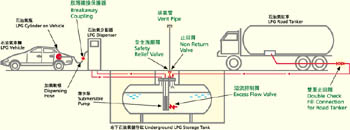LPG Vehicles
With about half a million vehicles in Hong Kong, nearly 30% are diesel
vehicles accounting for almost 70% of the total road usage in Hong Kong. Additionally
diesel vehicles account for 98% of respirable suspended particulates and around 80% of the
nitrogen oxide emitted by vehicles. Diesel vehicles are therefore the dominant source of
air pollution in the streets of Hong Kong. To improve air quality in Hong Kong and
introduce a practical and clean alternative to diesel vehicles the Government is actively
promoting the use of LPG Vehicles particularly among the 18,000 taxis in Hong Kong. Note 1
 To ensure the viability and safety
of these vehicles a one-year road test was carried out on 30 taxis and successfully
concluded in November 1998. The results were highly positive showing that the performance
of LPG taxis was comparable to that of diesel taxis yet emissions were extremely low and
virtually free of smoke. Passengers also welcome the taxis finding them quieter and To ensure the viability and safety
of these vehicles a one-year road test was carried out on 30 taxis and successfully
concluded in November 1998. The results were highly positive showing that the performance
of LPG taxis was comparable to that of diesel taxis yet emissions were extremely low and
virtually free of smoke. Passengers also welcome the taxis finding them quieter and
more environmentally friendly. As a result, the Government is working towards the eventual
replacement of all diesel taxis with LPG models
by 2006.
 |
EMSD's role in this initiative has been on several
levels. Firstly as Hong Kong's Authority on Gas Safety, we are involved in all the safety
aspects of the scheme. These include mandatory safety control and approval of the LPG
vehicles, LPG filling stations, LPG vehicle workshops and competently trained LPG
Mechanics. Secondly as a technical adviser and consultant to the Government, EMSD forms a
part of the LPG Scheme Committee advising on technical issues. |

LPG Filling Station Safety Design
Activities to date include:
 The preparation of Safety Guidelines on the construction and
maintenance of LPG taxis and LPG filling stations. These include a range of requirements
and initiatives such as type approval of LPG cylinders and storage tanks as well as
safety, pressure and automatic valves to prevent the build up of pressure or leakage. The preparation of Safety Guidelines on the construction and
maintenance of LPG taxis and LPG filling stations. These include a range of requirements
and initiatives such as type approval of LPG cylinders and storage tanks as well as
safety, pressure and automatic valves to prevent the build up of pressure or leakage.
 The monitoring and supervision of LPG filling stations. We also
carried out the identification of suitable sites for dedicated LPG filling stations and
tenders for the design, construction and operation of 5 more dedicated LPG filling
stations were issued in December 1999. These stations are expected to be operational by
the end of 2000. Together with the provision of LPG facilities in 17 existing petrol
stations, it is anticipated that there will be 26 LPG filling stations in operation at the
end of 2000, growing to 37 at the end of 2001. The monitoring and supervision of LPG filling stations. We also
carried out the identification of suitable sites for dedicated LPG filling stations and
tenders for the design, construction and operation of 5 more dedicated LPG filling
stations were issued in December 1999. These stations are expected to be operational by
the end of 2000. Together with the provision of LPG facilities in 17 existing petrol
stations, it is anticipated that there will be 26 LPG filling stations in operation at the
end of 2000, growing to 37 at the end of 2001.
 We have issued guidelines and requirements for the
setting up of LPG vehicle workshops to the vehicle service trade. So far, 29 suitable
sites have been identified and we have received 11 applications for the setting up of
these workshops. Permit-to-use approval has been granted to 2 workshops and construction
approval for 3 other workshops has also been given. We have issued guidelines and requirements for the
setting up of LPG vehicle workshops to the vehicle service trade. So far, 29 suitable
sites have been identified and we have received 11 applications for the setting up of
these workshops. Permit-to-use approval has been granted to 2 workshops and construction
approval for 3 other workshops has also been given.
 Currently, we have granted Type Approval to 4 LPG taxi models
and applications from other LPG taxi suppliers are being processed. Currently, we have granted Type Approval to 4 LPG taxi models
and applications from other LPG taxi suppliers are being processed.
|
 |
 The Vocational Training Council has trained 235 LPG mechanics
so far. 137 of them have been registered with EMSD under the Gas Safety Ordinance. The Vocational Training Council has trained 235 LPG mechanics
so far. 137 of them have been registered with EMSD under the Gas Safety Ordinance.
 We monitor the maintenance of the two LPG vehicles under trial
in the Government fleet and have also issued an order, on behalf of the Environment
Protection Department, for a third LPG vehicle which will act as a mobile environmental
resources centre. We monitor the maintenance of the two LPG vehicles under trial
in the Government fleet and have also issued an order, on behalf of the Environment
Protection Department, for a third LPG vehicle which will act as a mobile environmental
resources centre.

ZOOM
Note 1 Figure based on information extracted from the
Discussion Paper of 5 November 1999, Legislative Council, Panels of Environmental Affairs
and Transport, Comprehensive Control of Diesel Vehicle Emissions. |
 To ensure the viability and safety
of these vehicles a one-year road test was carried out on 30 taxis and successfully
concluded in November 1998. The results were highly positive showing that the performance
of LPG taxis was comparable to that of diesel taxis yet emissions were extremely low and
virtually free of smoke. Passengers also welcome the taxis finding them quieter and
To ensure the viability and safety
of these vehicles a one-year road test was carried out on 30 taxis and successfully
concluded in November 1998. The results were highly positive showing that the performance
of LPG taxis was comparable to that of diesel taxis yet emissions were extremely low and
virtually free of smoke. Passengers also welcome the taxis finding them quieter and 


